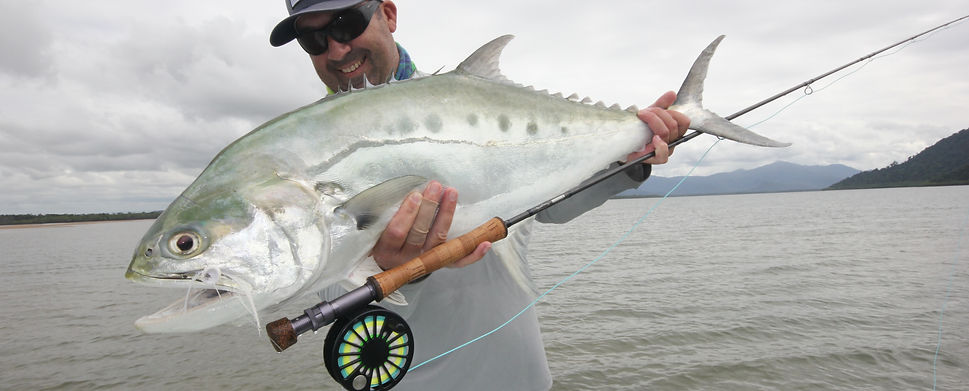

Anak Permit
Permit
If you think of flyfishing for permit in Australia, you think of Hinchinbrook Island. Both species the blocchi (Trachinotus blochii) and anak (Trachinotus anak) can be found here. This is the main target fish and why both local and international guests make a trip to the Lodge, as it's the premier location in Australia to target these fish. The blocchi are predominantly found on the beaches on the front of the Island, with the anak more commonly found on the flats inside of the channel. The place just sets up perfect, lots of feed beds with gutters close to deep channels and the fact you can find permit all year round here. Fishing for permit is a percentage game, the more shots you have the better chance you have of catching one of these prized fly targets. This is why waters located around the Lodge is a stand out location because of sheer numbers you see here. In the 2016 season two guests both scored four permit days, which is simply exceptional permit fishing. This is also the birthplace of permit flyfishing in Australia as it was these waters the first ever permit was caught.

Barramundi
Hinchinbrook has always been recognized as a great fishery for the iconic barramundi and its flats offer the fly angler some incredible shallow water sight fishing to laid up or tailing barramundi. Best of all there are vast areas around the Island to do this style of fishing. On overcast days if you can’t get on the sand flats you can sight fish barramundi all day long. It is a great option to have up your sleeve. To the north the expanses of mud flats inside the scenic Missionary Bay, which is also a net free zone, is a great place to look on south easterly winds. Moving inside the main channel the western shores of the Island are dominated by long stretches of mangrove root systems. On the mainland side, the fallen timbers banks are the reminiscence of cyclone Yasi, all prime barramundi habitat. Neap tides are the best to target these shallow water barramundi, it brings cleaner water and the fish are not in a rush to get off the flats. The water hangs on the edges a lot longer giving you more time on where you need to be. Early in the season, after the rains, barramundi feed heavily on jelly pawns, it is not uncommon for schools of barramundi working their way up and down the flats popping these jellies like a pack of wolves. A small unweighted tan clouser fished through the schools is a real killer when you find them in this mood. At this time of year you can also see tailing barramundi with their heads in the mud. It is quite an unusual event, which is very exciting fishing. As the season moves on into winter you can find laid up barramundi sunning themselves in the ultra clear water, typically these are single fish you will be seeing. A gently landed toad or bunny fly on a barramundi’s nose is the best bet; they are lazy fish and in the clear shallow water are even more uninclined to move out of their holding spot to take a fly. Moving into the warmer months barramundi start to school up, a good place to find them now are the edges of gutters and snake drains on the flats. Around this time of year mangrove jack are in good numbers, which are great bycatch when fishing for barramundi in the shallows. Visually seeing a barramundi eat the fly in clean shallow water is quite an experience.

Golden Trevally
The golden trevally is adored by saltwater flyfishing anglers. It was this fish that started the saltwater flats evolution in Australia. They are a very user friendly fish for fly anglers. They eat the fly well, love to tail, they grow up to 20 pounds+ and fight very well. They frequently inhabit the waters around the Lodge and are commonly caught by Lodge guests.

Queenfish
Queenfish is the angry fish of the flats and a superb fighter. To add to that, their aerial acrobatics show they put on once hooked is thrilling. Their hard strike on the fly makes them a very exciting fly target and they love to eat popper flies. During the right seasons and tides on certain flats you can find schools of big queenfish moving across the shallow sand flats. On the flats it’s not uncommon for fly anglers to have shots at fish up to 120cm long.

Giant Trevally
Giant Trevally are the nomads of the flat around Hinchinbrook Island. They have no set pattern and usually show up when least expected. The big fish are usually singles or pairs that can be often excess of 50 pounds with the larger schools ranging around the 10 pound mark. The great thing about hooking big GT’s in these waters, is that they are caught on the open sand flats so the angler usually wins the battle with a well set hook.

Mangrove Jack
The mighty mangrove jack is a hard hitting strong fighting fish. They hit the fly with real force and the fight can be over quickly if they manage to get you back to their lairs. You can target jacks around timber, gutters, rock bars and drains.
Other Species
There are a host of other fish that can be caught in the waters around the Lodge. In the bluewater, longtail and mack tuna can be found. Inside the channel grunter, fingermark, blue salmon, threadfin, triple tail and baby tarpon can be found. Whilst diamond trevally, giant herring and barracuda can be found roaming the flats.